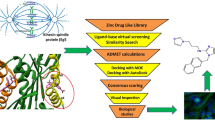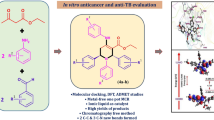Abstract
Tuberculosis (TB) is the major cause of human mortality from a curable infectious disease, attacking mainly in developing countries. Among targets identified in Mycobacterium tuberculosis genome, enzymes of the shikimate pathway deserve special attention, since they are essential to the survival of the microorganism and absent in mammals. The object of our study is shikimate kinase (SK), the fifth enzyme of this pathway. We applied virtual screening methods in order to identify new potential inhibitors for this enzyme. In this work we employed MOLDOCK program in all molecular docking simulations. Accuracy of enzyme-ligand docking was validated on a set of 12 SK-ligand complexes for which crystallographic structures were available, generating root-mean square deviations below 2.0 Å. Application of this protocol against a commercially available database allowed identification of new molecules with potential to become drugs against TB. Besides, we have identified the binding cavity residues that are essential to intermolecular interactions of this enzyme.






Similar content being viewed by others
References
World Health Organization (2009) WHO Report. Geneva. Switzerland. WHO/CDS/TB/2009. http://www.who.int/topics/tuberculosis/en/. Accessed in October 2010
Basso LA, Pereira Da Silva LH, Fett-Neto AG, De Azevedo Jr WF, Moreira IS, Palma MS, Calixto JB, Astolfi Filho S, dos Santos RR, Soares MBP, Santos DS (2005) Mem Inst Oswaldo Cruz 100:475–506
Davies GM, Barrett-Bee KJ, Jude DA, Lehan M, Nichols WW, Pinder PE, Thain JL, Watkins WJ, Wilson RG (1994) Antimicrob Agents Chemother 38:403–406
Coggins JR (1989) The shikimate pathway as a target for herbicides. In: Dodge AD (ed) Herbicides and Plant metabolism. Cambridge University Press, Cambridge, UK, pp 97–112
Bentley R (1990) The shikimate pathway-a metabolic tree with many branches. Crit Rev Biochem Mol Biol 25:307–384
Ratledge C (1982) Nutrition, growth and metabolism. In: Ratledge C, Stanford JL (eds) The Biology of the Mycobacteria, vol 1. Academic, London, pp 185–271
Krell T, Coggins JR, Lapthorn AJ (1998) The three-dimensional structure of shikimate kinase. J Mol Biol 278:983–997
Pereira JH, Oliveira JS, Canduri F, Dias MVB, Palma MS, Basso LA, Santos DS, De Azevedo Jr WF (2004) Acta Crystallogr D Biol Crystallogr 60:2310–2319
Parish T, Stoker NG (2002) The common aromatic amino acid biosynthesis pathway is essential in Mycobacterium tuberculosis. Microbiology 148:3069–3077
Vonrhein C, Schlauderer GJ, Schulz GE (1995) Movie of the structural changes during a catalytic cycle of nucleoside monophosphate kinases. Structure 3:483–490
Gu Y, Reshetnikova L, Li Y, Wu Y, Yan H, Singh S, Ji X (2002) Crystal structure of shikimate kinase from mycobacterium tuberculosis reveals the dynamic role of the LID domain in catalysis. J Mol Biol 319:779–789
Peitsch MC (2004) Manuel Peitsch discusses knowledge management and informatics in drug discovery. Drug Discov Today Biocilico 02:94–96
Dias MV, Vasconcelos IB, Prado AM, Fadel V, Basso LA, De Azevedo Jr WF, Santos DS (2007) Acta Crystallogr F Struct Biol Cryst Commun 63:1–6
Thomsen R, Christensen MH (2006) MolDock: a new technique for high-accuracy molecular docking. J Med Chem 11:3315–3321
De Azevedo Jr WF, Canduri F, Da Silveira NJF (2002) Biochem Biophys Res Commun 293:566–571
Friesner RA, Banks JL, Murphy RB, Halgren TA, Klicic JJ, Mainz DT, Repasky MP, Knoll EH, Shaw DE, Shelley M, Perry JK, Francis P, Shenkin PS (2004) Glide: a new approach for rapid, accurate docking and scoring. 1. Method and assessment of docking accuracy. J Med Chem 47:1739–1749
Thilagavathi R, Mancera RL (2010) Ligand-protein cross-docking with water molecules. J Chem Inf Model 50:415–421
Irwin JJ, Shoichet BK (2005) ZINC - a free database of commercially available compounds for virtual screening. J Chem Inf Model 45:177–182
Timmers LFS, Pauli I, Caceres RA, De Azevedo Jr WF (2008) Drug-binding databases. Curr Drug Targets 9:1092–1099
De Azevedo Jr WF (2010) Structure-based virtual screening. Curr Drug Targets 11:261–263
De Azevedo Jr WF (2010) MolDock applied to structure-based virtual screening. Curr Drug Targets 11:327–334
Yang JM (2004) Development and evaluation of a generic evolutionary method for protein-ligand docking. J Comput Chem 25:843–857
Yang JM, Chen CC (2004) GEMDOCK: a generic evolutionary method for molecular docking. Proteins 55:288–304
Miteva MA, Violas S, Montes M, Gomez D, Tuffery P, Villoutreix BO (2006) FAF-drugs: free adme/tox filtering of compound collections. Nucleic Acids Res 34:W738–W744
Lipinski CA, Lombardo F, Dominy BW, Feeney PJ (1997) Experimental and computational approaches to estimate solubility and permeability in drug discovery and development settings. Adv Drug Deliv Rev 23:3–25
Mulabagal V, Calderón AI (2010) Development of an ultrafiltration-liquid chromatography/mass spectrometry (UF-LC/MS) based ligand-binding assay and an LC/MS based functional assay for Mycobacterium tuberculosis shikimate kinase. Anal Chem 82:3616–3621
Huang N, Shoichet BK, Irwin JJ (2006) Benchmarking sets for molecular docking. J Med Chem 49:6789–801
Brooijmans N, Sharp KA, Kuntz ID (2003) Molecular recognition and docking algorithms. Annu Rev Biophys Biomol Struct 32:335–373
Segura-Cabrera A, Rodriguez-Perez MA (2008) Structure-based prediction of Mycobacterium tuberculosis shikimate kinase inhibitors by high-throughput virtual screening. Bioorg Med Chem Lett 18:3152–3157
Kumar M, Verma S, Sharma S, Srinivasan A, Singh TP, Kaur P (2010) Structure-based in silico design of a high-affinity dipeptide inhibitor for novel protein drug target Shikimate kinase of Mycobacterium tuberculosis. Chem Biol Drug Des 76:277–284
Noble ME, Endicott JA, Johnson LN (2004) Protein kinase inhibitors: insights into drug design from structure. Science 303:1800–1805
Canduri F, De Azevedo Jr WF (2005) Structural basis for interaction of inhibitors with cyclin-dependent kinase 2. Curr Comput-Aid Drug 1:53–64
Lawrie AM, Noble ME, Tunnah P, Brown NR, Johnson LN, Endicott JA (1997) Protein kinase inhibition by staurosporine revealed in details of the molecular interaction with CDK2. Nat Struct Biol 4:796–801
De Azevedo Jr WF, Mueller-Dieckmann HJ, Schulze-Gahmen U, Worland PJ, Sausville E, Kim SH (1996) Structural basis for specificity and potency of a flavonoid inhibitor of human CDK2, a cell cycle kinase. Proc Natl Acad Sci USA 93:2735–2740
De Azevedo Jr WF, Leclerc S, Meijer L, Havlicek L, Strnad M, Kim SH (1997) Inhibition of cyclin-dependent kinases by purine analogues: crystal structure of human cdk2 complexed with roscovitine. Eur J Biochem 243:518–526
Wallace AC, Laskowski RA, Thornton JM (1995) LIGPLOT: a program to generate schematic diagrams of protein-ligand interactions. Prot Eng 8:127–134
Acknowledgments
The authors would like to express their gratitude to the reviewers for their valuable comments and suggestions. This work was supported by National Institute of Science and Technology on Tuberculosis (Decit/SCTIE/MS-MCT-CNPq-FNDCTCAPES). W.F.A. Jr. is a research fellow of the National Council for Scientific and Technological Development of Brazil (CNPq). C.P.V. acknowledges a scholarship awarded by Coordenação de Aperfeiçoamento de Pessoal de Nível Superior (CAPES).
Author information
Authors and Affiliations
Corresponding author
Rights and permissions
About this article
Cite this article
Vianna, C.P., de Azevedo, W.F. Identification of new potential Mycobacterium tuberculosis shikimate kinase inhibitors through molecular docking simulations. J Mol Model 18, 755–764 (2012). https://doi.org/10.1007/s00894-011-1113-5
Received:
Accepted:
Published:
Issue Date:
DOI: https://doi.org/10.1007/s00894-011-1113-5




